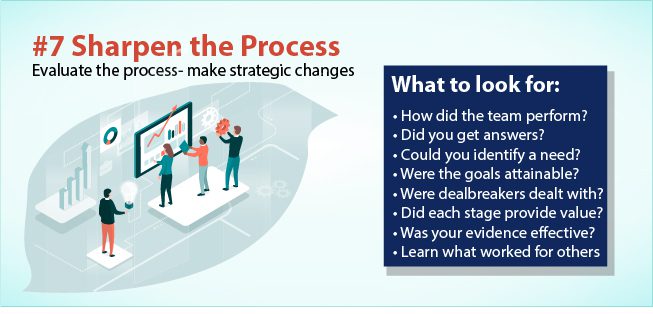Evaluating Legal Ops Solutions: Seventh, Sharpen Best Practices
#7 in the new Blog Series: How to Evaluate Legal Operations Solutions
This is the final Post in the Blog Series: How to Evaluate Legal Operations Solutions
Now that you’ve created your evaluation team, asked the right questions, determined the actual needs, set achievable goals, watched out for dealbreakers, gathered the evidence to support your findings, it’s time to look back and evaluate your process to sharpen best practices for future evaluations. Ensure the value has been there throughout the project. If a step lacked the information you used to justify your findings, consider if it was worth the time and effort spent. This step-by-step process is a work-in-progress and should be evaluated each time to build your own best practices. Your team’s job is to provide useful feedback and take a hard look at each stage to decide if it should be kept next time.
At this point in your evaluation process, you have enough information to answer questions that will shape the way the process is used for the next round – and enough to sharpen your best practices for judging the value of Legal Operations solutions. Human error and mistakes along the path can transform obstacles into opportunities for defining the steps that will yield the best outcomes. At this stage in the process, your best practices need to be repeatable, consistent, and reliable when looking at bringing in other LegalTech tools.

You began this process knowing that your legal team needed help to manage their evolving workload, increase efficiency, and reduce expenses. And you were right: According to a recent Thomson Reuters survey, in-house teams are increasingly focusing on areas like digital document storage and knowledge management, resulting in far less time spent searching for previously buried organizational knowledge, forms, and templates. They are also trying to maximize their productive work so that they can contribute more effectively to the department’s bottom line. To manage their day-to-day tasks, legal technology solutions often enhance performance to meet their need.
While deploying technology is a proven way to accomplish many of your goals, choosing the best solution continues to be a stumbling block. What’s more, reports and surveys indicate Legal’s responsibilities will continue to escalate, due to the impact of the pandemic.
We have explored the entire process leading up to whether or not to bring in a new Legal Ops technology solution. The goal of this whole process was always to ensure that legal technology helps your team analyze the business data available to make intelligent decisions and optimize team performance and sharpen your best practices.
Ninja Tip: Tightening budgets, reduced staff, and a heightened need for solutions that manage the increasing workload is mandating a time-tested process in place to make the right decision on LegalTech solutions. To ensure your team performs at its peak, your first objective is to measure that value by taking a hard look at results. That is how you’ll sharpen your best practices to ensure positive results.
Look inward: How did your team perform?
The first step is to scrutinize the results to date, objectively, quantifiably, and honestly. Taking in these dispassionate measurements will give a non-biased vision of your work. Ask for opinions from your team members to get a grasp of the team’s overall performance:
- How well did your team perform versus expectations?
- Which changes would you make to the team for the next round?
- What conflicts arose that delayed moving forward?
Ninja Tip: A helpful measurement will also come from other internal teams that were involved in the evaluation. These will give a non-biased assessment of the team’s performance during the project.
Did you get your answers?
If you felt there were not enough answers at any point during the process, you should explore how that could have been addressed during the project. Record the plan for the next round.
- Did any step not provide enough answer value to keep it?
- Were your questions unanswered, or did you receive negative feedback?
- Did the answers you received provide a clear direction at each stage?
Ninja Tip: If, for whatever reason, the answers weren’t readily available, would the process have benefited from waiting for those answers before proceeding? Make sure to make note of the results of not having any necessary answers. Did it affect the later stages of the process?
Were you able to identify a clear business need?
The business need is the issue that must be addressed and resolved by bringing in a different solution. A clear need is a driving reason for the change. Without a need, there simply isn’t enough pain to drive a significant change.
- Were there any hurdles to identifying enough need to continue?
- Would your business benefit from regular meetings to identify needs before starting the next evaluation?
Ninja Tip: If the benefits of bringing in a solution can meet or exceed that need, even budgetary restrictions can be overcome.
Were your business goals attainable?
No goal is worth pursuing if it has no chance of being met. Take a hard look at what you thought were your goals. In hindsight were they truly attainable? If not, keep track of what made you set that goal. Many times, teams change the goal mid-stream, to adjust to the reality of the process.
- Were you able to achieve each goal identified for the project?
- Were you able to measure the progress toward reaching that goal?
- Would you change the goal structure to ensure better achievement?
Ninja Tip: Not every goal will survive the process. We tend to think optimistically at the onset of any project like this. Reality tends to cause us to adjust for the next round. It is important to stay accurate and genuine in appraising your success here.
Were dealbreakers addressed and overcome?
Dealbreakers can be the hardest part to assess in hindsight. Each project is different, and most business issues present their own set of challenges. For this part, you should evaluate your team’s ability to communicate effectively and honestly, as well as their ability to see things before they cause failure.
- How effective was your team at identifying dealbreakers?
- How quickly were they addressed?
- Did this derail the process in any way?
Ninja Tip: Dealbreakers can separate the good from the great teams. Your team’s willingness to dive in to seek answers, to identify problems quickly, and to find a majority resolution to any dealbreakers will indicate if members performed well enough to remain a part of the team on the next round.
Did each step provide enough value?
No process is perfect for every situation. The idea is to build a process that works for you and your organization. Use the track record to define and refine your own process to ensure the best results. This checklist provides a guide to work from when evaluating new solutions. Did each value provide enough for you to keep it in the next round?
- Which steps should you keep for the next round?
- Did any steps delaying the decision found unnecessary or avoidable?
- Did any step provide so little value to the decision that it should be eliminated?
Ninja Tip: The value you receive from each step is the only measurement you need to use here. This isn’t a subjective measurement: It is strictly determined by whether the information in each step moved the project forward. If not, don’t waste time — consider removing it.
Were you effective in gathering necessary evidence?
Evidence is the backing your team needed to prove their case. The ability to present the evidence also needs to be measured. The team’s effectiveness in collecting, analyzing, and presenting the evidence in a clear and concise way is a key performance indicator.
- Was your information received well by all stakeholders?
- Was your data trusted by the final decision-makers?
- What was the outcome of the presentation of evidence?
Ninja Tip: The best evidence presented poorly can derail and obscure the best project results. Be honest about what your team was able to uncover and whether the evidence presented drove a truly data-driven decision.
Evaluate your evaluation process by taking a “big picture” look at the process itself
The only way to improve is to measure, evaluate, and adjust your own process. Keep what works and lose (or alter) what didn’t. This is a team discussion and determination, so involve each member. They lived the process the entire time with you. Their input and feedback are vital to maintaining a working process that results in the best outcomes.
- What worked well and what did not?
- Would the project have profited from other steps?
- If you found issues, could they have been handled more effectively?
Ninja Tip: This is the final outcome measurement. Change what is needed to ensure a better result on the next solution evaluation. It’s a fluid process that needs to be adjusted and refined. However, if your team knocked it out of the park, why mess with success?
Now, look outward: What are best practices for other ops teams?
Since the objective of best practices is to help your internal legal operations team run more efficiently and make better decisions, the place to start is to look at how other teams in your organization approach best practices. You have probably been working with other departments’ team members from the onset of this evaluation process, so asking them to share information, suggestions, and internal wisdom makes sense as you complete the project. You also have the ability to learn from other legal colleagues’ success. Ask what they did to reach their outcomes. Legal conferences are a useful way to learn from other professionals.
You might first ask colleagues on other internal legal ops teams about their guidelines on:
- Sourcing: the evaluation process itself
- Best practices that support corporate goals and strategies
- Each project’s complexity and potential for standardization
You’ve now come full circle, and if you recall our second post in this series – Ask Questions – you may want to review and compare your observations then versus now. What did you learn? How could you apply that knowledge to gain more value from the process as you and your team move forward?
Ninja Tip: Keep asking questions, stay curious, and use the standard news writing model: who, what, when, where, and why to keep sharpening your best practices.
Moving forward from here
While every company’s checklist will vary, yours should look something like this:
- Assemble the team (Read this post)
Start a conversation with leaders in every business unit that touches yours, and, if appropriate, invite them to be part of your evaluation team. - Ask incisive questions (Read this post)
Get to the heart of the business issue and identify a quantifiable goal. - Evaluate the need (Read this post)
Consider whether the need is great enough to commit your collective resources. - Set goals (Read this post)
Look at quantifiable goals for short-term (now through the next year) and longer-term (through the next 3-5 years) time periods. Make them measurable. - Watch for dealbreakers (Read this post)
Discuss what, if anything, would jeopardize a decision. - Gather evidence (Read this post)
Collect evidence from every source possible. Learn how to present it in the most effective way to support your findings. - Follow best practices (You’re reading this post)
It’s quite possible that examples of what other teams have done will include a formal or informal list of best practices – or at least some insights for creating that list.





